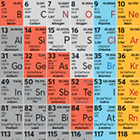150 Years Of The Periodic Table!
The periodic table of chemical elements celebrates its 150th anniversary.
Let’s celebrate this birthday, test your knowledge and learn more about our products.

If you want to know all the physical properties by element, click in the different boxes to the right...
See all periodic tables available in our portfolio:
Additional Resources
- Atomic weight: Table | Chart
- Melting point: Table | Chart
- Electronegativity
- Oxidation state: Table | Chart
- Electron configuration
- Sold-gas-liquid (physical state): Table | Chart
Who created the periodic table?
The modern periodic table was developed by a Russian chemist Dmitri Mendeleev who published the first recognisable periodic table on March 6th 1869. In developing it, what Mendeleev did was start arranging elements in order of atomic weight, and then grouping them.
What is the organisation of the periodic table?
The periodic table is a tabular display of chemical elements which are arranged by atomic number, electron configuration and recurring chemical properties. The structure of the table shows periodic trends. The seven rows of the table (called periods), generally have metals on the left and non metals on the right. The columns (called groups), contain elements with similar chemical behaviours. Six groups have accepted names as well as assigned numbers: For example, group 17 elements are the halogens, and group 18 are the noble gases. Also displayed are four simple rectangular areas (or blocks) associated with the filling of different atomic orbitals.
What elements have recently been added? How were these new elements discovered?
The most recent ones have been Nihonium, Moscovium, Tennessine and Oganesson - numbers 113, 115, 117 and 118. Nihonium is the first modern element to be discovered in an Asian country. These came from particle accelerators and are being produced. So, essentially you have a target - something to hit - and you’ve got to have a particle that’s hitting it. Then you’re looking at what comes out; it’s done very fast. These new elements are the result of chemists and physicists working together. So, there’s design, technology and resources that go into making elements like this.
What is the objective of this kind of research?
It provides a better understanding of our universe and it furthers technology. What can we do, and what can we learn?